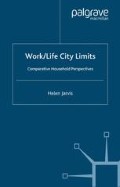Abstract

Homeless in San Francisco (central reservation, Van Ness Avenue)
A recurring theme of this book is that behind the picture postcard image of successful cities are profound inequities. Staying at the downtown Berkeley YMCA1 from August to November 2000, I was shocked to discover how many low-wage workers called this budget hotel accommodation home. I also observed men and women sleeping rough. Indeed, by 2003 street homelessness had attracted such public concern that the issue dominated the San Francisco mayoral race (Calvan 2003). I regularly met the same ‘guests’ in the one communal kitchen and this way got to know the work routines of two African American men, Sol and Dino, both long-term residents of the YMCA and experts in the art of living frugally. It was Sol who advised me not to store food in the open shelves provided. Instead, he had a brown paper sack (the sort routinely provided by US supermarkets) as his ‘larder’ and used this to carry sugar, peanut butter and other condiments to and from his bedroom, along with a small cool-box. Most meals consisted of ramen instant noodles, hot-dogs and Pop-Tarts: those heavily processed foods which require only basic kitchen preparation. That both men were unhealthily overweight was a consequence of them camping out rather than over-eating.
Access this chapter
Tax calculation will be finalised at checkout
Purchases are for personal use only
Preview
Unable to display preview. Download preview PDF.
Notes
2. Barbara Ehrenreich (2001) could find no statistics on the number of employed people living in cars or vans though it is estimated that nearly one-fifth of all homeless people in the USA are in paid employment (p. 26). Anecdotal evidence suggests that a car often provides refuge during periods of temporary homelessness and this is a notable cultural (logistical) difference between the USA and UK. A used car which is relatively cheap to run is possibly the most valuable asset anyone can have ‘to get by’ in the USA and consequently the last asset to be relinquished when facing hard times. The opposite is true in the UK where running a car is prohibitively expensive for low-wage workers. UK homeless workers also lack access to the sort of non-traditional housing options common in the USA, where less stringent regulations encourage a market for rented trailers (caravans), mobile and manufactured homes and adapted out-buildings. In contrast, it is estimated that the number of family households staying in bed and breakfast accommodation (as a form of local authority provision in situations of homelessness) increased three-fold in London between 1997 and 2002 as a consequence of housing shortage and high cost of living (National Statistics Online 2004)
Author information
Authors and Affiliations
Copyright information
© 2005 Helen Jarvis
About this chapter
Cite this chapter
Jarvis, H. (2005). Equity. In: Work/Life City Limits. Palgrave Macmillan, London. https://doi.org/10.1057/9780230503304_5
Download citation
DOI: https://doi.org/10.1057/9780230503304_5
Publisher Name: Palgrave Macmillan, London
Print ISBN: 978-1-349-51200-3
Online ISBN: 978-0-230-50330-4
eBook Packages: Palgrave Social & Cultural Studies CollectionSocial Sciences (R0)

